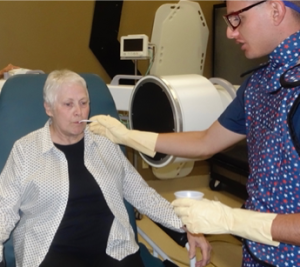Chapter 3: Swallow Evaluation

In a general medical evaluation, an array of information-gathering techniques are employed to aid in the development of a list of possible diagnoses (i.e., your differential diagnosis list). Information gained from the medical record, clinical interview, clinical exam and diagnostic procedures are used to strengthen or reduce your confidence in each suspected diagnosis. The end result is a clinical hypothesis that ties together the signs and symptoms, diagnosis, and potential treatment approaches. The dysphagia evaluation is no exception to this medical format. The history of the swallow problem and other relevant information is gathered. Guided by a list of differential diagnoses, specific clinical and/or instrumental procedures are performed. As a result of the evaluation, referrals and recommendations are defined. Results are communicated, as needed, with the primary care physician, patient, and other members of the dysphagia team. This text focuses on aspects of the dysphagia evaluation performed by the speech-language pathologist. Use of the term “dysphagia clinician” denotes a speech-language pathologist with interest and expertise in disorders of feeding and/or swallowing.
Learning Objectives
Upon completion learners will be able to:
- Describe and perform a swallow screening
- Describe the difference between a screening and an evaluation
- Perform a clinical evaluation of swallowing
- Perform an oral mechanism exam
- Describe the procedures for common instrumental exams—FEES and VFES
- Describe the risks and limitations of various diagnostic procedures
- Perform general interpretation of VFES
- Perform general interpretation of FEES
Reading Guide
1. What is the difference between a screening and an evaluation? What are the goals of each?
2. Generate a list of common “red flags” associated with dysphagia. These can include signs & symptoms, diseases, medical procedures, past medical history etc…
3. Discuss impact of age screening. Address both pediatric and advanced age.
4. Describe the impact of cognition on a swallow evaluation.
5. List and describe areas that should be addressed in the clinical interview. Provide sample questions for each category.
6. Discuss the impact of respiratory health on swallowing.
7. Develop a form that can be used to perform an oral mechanism exam on a patient with dysphagia.
8. Develop a template that can be used for an adult clinical swallow evaluation.
9. What methods can be used during the oral mechanism exam to quantify strength and range of movement of oropharyngeal structures?
10. List and describe phonatory measures that can be used to aid in the evaluation of swallowing.
11. List the procedures and describe the benefits of using manual palpation with a trial water swallow.
12. Describe the uses of pulse oximetry in the dysphagia evaluation. What are the pro and cons of pulse oximetry?
13. Describe the uses of and the pros and cons of cervical auscultation.
14. Describe a procedure for a VFES. List 5 observations that you may see during the exam. Provide an interpretation and relate it to the swallow deficit. For e.g., during bolus development, you observe spillage of a piece of the bolus into the pharynx. The potential interpretations include: reduced lingual velar value function or reduced oral strength impacting bolus control. Observations and interpretations can be presented in table format.
15. Describe a procedure for a FEES. List 3 observations that you may see during the exam. Provide an interpretation and relate it to the swallow deficit. Observations and interpretations can be presented in table format.
This chapter covers:
- Swallow Screening
- Clinical & Instrumental Evaluation of Swallowing

